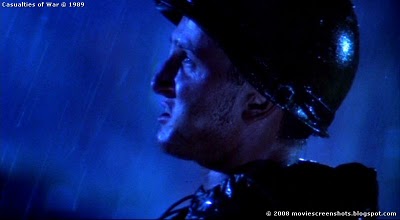From the Chicago Reader (September 1, 1989). — J.R.
CASUALTIES OF WAR
** (Worth seeing)
Directed by Brian De Palma
Written by David Rabe
With Michael J. Fox, Sean Penn, Don Harvey, John C. Reilly, John Leguizamo, Thuy Thu Le, and Erik King.
“It is, of course, immediately evident that there is a possible position omitted from the fierce debate between the hawks and the doves, which allegedly tore the country apart during these trying years: namely, the position of the peace movement, a position in fact shared by the large majority [over 70 percent] of citizens as recently as 1982: the war was not merely a ‘mistake,’ as the official doves allege, but was ‘fundamentally wrong and immoral.’ To put it plainly: war crimes, including the crime of launching aggressive war, are wrong, even if they succeed in their ‘noble’ aims. This position does not enter the debate, even to be refuted; it is unthinkable, within the ideological mainstream.” — Noam Chomsky, “The Manufacture of Consent” (1984)
I’ve never been much of a Brian De Palma fan, but it would be silly to deny that Casualties of War shows his talents, such as they are, at their near best — disregarding for the moment what he does with them. Several years ago, Jean-Luc Godard praised him for his “work on the image,” which I was somewhat dubious about at the time, but this work is plainly evident here in the thoughtfulness of his deep-focus, wide-screen framing, particularly certain unorthodox uses of the right and left edges of the frame — a compositional strategy that will be lost when the film winds up on video and loses its wide-screen format.
To be perfectly honest, for all my skepticism about De Palma, I even found his Hitchcock rip-offs somewhat interesting in spite of their many irritations. I liked the split screens in Sisters, the use of Bernard Herrmann’s score in Obsession (which guided the plot somewhat more gracefully than Paul Schrader’s overwrought script), the uses of Angie Dickinson and Nancy Allen in Dressed to Kill, the attention given to sound in Blow Out (which managed to crib plenty from Antonioni and Coppola as well as Hitchcock), the feeling for space in Body Double. But the ugliness of the director’s attitude toward both his characters and his audience, the sheer clamminess of his “touch,” always spoiled part of the fun, and I found the main defense of De Palma being offered by Pauline Kael and her legion of followers — which was essentially that movie trash was better than movie art because it socked you in the gut and made you feel down and dirty — pretty childish and unedifying. Considering De Palma’s pathetic reliance on other directors for most of his themes, plot twists, and formal ideas, it seemed singularly perverse to keep on implying, as the Kael position did, that if poor Alfred had only applied himself a little and dirtied up his act — goosed up his editing, accelerated and multiplied his camera movements so that they went beyond logical dramatic requirements, and poured on a few more tons of gore and sleaze — he might have achieved works of true genius like our golden boy Brian.
If De Palma’s shamelessness in reaching for any kind of excess to juice up his rusty and borrowed vehicles sometimes gave his work an undeniable lift — a sense that anything could and would happen, no matter how far it went over the top — it also had the grim consequence of eventually turning almost everything he touched into florid kitsch. I treasure Howard Hawks’s Scarface much too much to prefer De Palma’s remake, but at least he pumped it up with a contemporary vulgarity, drive, and energy that gave it, with the help of Al Pacino and screenwriter Oliver Stone, a certain identity and integrity of its own. But when he offers a cartoonish version of the Odessa-steps sequence from Eisenstein’s Potemkin at a crucial juncture in The Untouchables, the “hommage” is so grossly demeaning to its source (and that source’s context) that it reminds me of a record album encountered in my youth called Back Beat Symphony, which contrived to serve up Schubert and Brahms in rock-and-roll versions.

When it comes to ideas — whether these are film ideas or thematic ideas — De Palma has the range of a mud turtle, and his tendency to let all the melodramatic stops out is clearly linked to a refusal or inability to budge from his initial premises. The delirium of his style, in other words, is predicated on the stubbornly maintained narrowness of his vision, making all of his films a kind of double-dealing arrangement struck between freedom and constraint, purple passages and repression.
Casualties of War, however, is something new in the De Palma canon: a film that asks to be regarded and defended (even by the Kaelian antiaesthetic) as something higher — or at least other — than kitsch or trash. It’s been reported that De Palma has wanted to make this film for 20 years, ever since Daniel Lang’s account of the true-life Vietnam-war incident on which the movie is based first appeared in the New Yorker. It certainly aims for a moral earnestness that finds very little precedent in De Palma’s work, apart from the recurring theme of male helplessness in the face of female victimization. The Hitchcockian mechanics are still present, in a slightly submerged form, but they’re pressed into the service of fulfilling a nobler project. As Steven Spielberg said ingenuously to someone about this movie after a preview several months ago, “You’ll be thinking about this for a week.”
The central episode of the film is the kidnapping of a young Vietnamese woman (Thuy Thu Le) by an American squad of five men, and her subsequent gang rape and murder. This incident is framed by the viewpoint of a principled private in the squad named Eriksson (Michael J. Fox), who refuses to participate in the brutality and who eventually gets the other four soldiers (Sean Penn, Don Harvey, John C. Reilly, John Leguizamo) court-martialed, in spite of resistance from the upper echelons. He’s a sensitive individual whose soul remains in torment even after the court-martial because he failed to save the woman from her agonizing fate.
The whole story is told as a kind of fever-dream flashback; Eriksson is in San Francisco at the time of Nixon’s resignation and glimpses an Asian woman who reminds him of the woman in Vietnam. At the end of the picture, he follows her, and in a peaceful park that slopes down toward the bay, he briefly confronts her. “Do I remind you of someone?” she asks, and he says, “Yes.” Seeing his troubled expression, she goes on: “You had a bad dream, didn’t you?” “Yes,” he admits, as an offscreen chorus continues to rise in volume. “It’s over now, I think,” she says, effectively granting him absolution, and walks off into the distance.
Is it really correct to claim, as Bob Straus did in the Sun-Times last week, that Casualties of War is “as anti-war as a contemporary American movie probably can get”? If that were true, it would be impossible to expect any contemporary American movie about Vietnam to be antiwar, and one of the effects that Casualties of War has had on me has been to make me sick of all the allegedly antiwar Vietnam films that have come along to date — from Apocalypse Now and The Deer Hunter to Platoon and Full Metal Jacket. (I’ve argued in the past that the last of these isn’t really about Vietnam at all, but if it’s read as part of an ongoing movie discourse about the war, as it generally is, then I’m afraid it’s no less tainted.) In fact, I think that Straus is wrong, and that sizable portions of the American public are less Neanderthal in their moral judgment of the Vietnam war than Reagan, Bush, and Hollywood take them to be; but as long as the media continue to ratify this insulting and cynical reading of the general populace, it’s difficult to foresee any substantial improvements in the public discourse that we get about Vietnam.
Forget about the question of whether or not this country’s aggression in Vietnam was justified. Forget about whether there’s any continuity between this aggression and U.S. aggression that’s currently occurring elsewhere today, in places like Nicaragua. Forget about the question of whether the feeling of helplessness that this film dramatizes, valorizes, and even exalts only makes it that much easier to keep this aggression going. Forget that this isn’t even remotely a pacifist film — that the supreme moment of pure movie pleasure, which I enjoyed as much as anyone, occurs when the hero hits the main villain in the head with a shovel.
Forget about all of these things, and you may find that Casualties of War is every bit as moving, as stirring, and as morally serious as it wants you to believe it is. The first time I saw the movie, I managed to forget about half of the things above, and I had to keep forcing myself to remember the other half because the movie was so adept at persuading me not to think about it. Consequently, I was moved but appalled, in about equal measures. I went back to see the movie again a few days later, and found it less convincing and less moving, and, by the same token, less appalling — as well as less interesting.
I know that some of De Palma’s early movies, like Greetings (1968) and Hi, Mom! (1970), were counterculture satires that opposed U.S. aggression in Vietnam — or at least that’s the way that I vaguely remember them, and the way that they were perceived at the time (when it was still considered possible to take such a position in relative proximity to the mainstream). But such a position is nowhere present in Casualties of War, and in fact, if it were, the entire edifice constructed by De Palma and screenwriter David Rabe would be thrown into serious jeopardy. If U.S. involvement in Vietnam were a moral issue at all in this movie, then the knowledge of whether Eriksson enlisted or was drafted would surely be an important factor in his unending soul-searching, but the movie takes care to avoid this issue entirely. For all of the film’s pretensions of moral seriousness, it’s predicated on the assumptions that (1) Eriksson didn’t necessarily “choose” to fight in Vietnam, he just wound up there (unlike the many thousands of principled individuals who chose not to, in some cases at great cost), and (2) U.S. involvement in Vietnam, and implicitly all that it represents, is a “bad dream” that is now “over” (no one in the audience is encouraged to reflect even for a millisecond on Nicaragua, Cambodia, or Honduras, much less on Vietnam today). What emerges is a mud turtle’s morality, or, as Pat Aufderheide recently put it in In These Times, a movie that combines “a pornography of violence” with “a pornography of pity.”
One could argue that the central incident in this movie is mainly a pretext for the soul-searching of Eriksson, which is carefully framed to exist in a moral void. It is his suffering that finally winds up counting the most, not the suffering of the Vietnamese woman, which chiefly exists in order to make his own noble ordeal possible. (In this respect, Eriksson resembles Jesus in Scorsese’s The Last Temptation of Christ, not the lepers in the same movie.)
Although at least three of the members of the squad are treated as central-casting stereotypes in the usual De Palma manner — a hillbilly airhead (Reilly), a coward who sacrifices his scruples to risk making waves (Leguizamo), and a mean-spirited villain (Harvey) — De Palma, Rabe, Fox, and Penn make a concerted effort to invest Eriksson and the sergeant with a bit more moral complexity and ambiguity. (During certain key moments, the mise en scene contrives to set up conflicting focal points in the foreground and background, implicating the audience in the conflicts that result from this ambiguity.) But the positioning of the movie as a whole makes this effort viable only if one agrees to participate in the collective amnesia that makes such moral conceits possible. Presumably it’s still OK to bomb any country back to the Stone Age to “make it safe for democracy” as long as you show compassion for the local populace, don’t rape or murder any potential allies, and suffer sufficient moral pangs about your helplessness.








